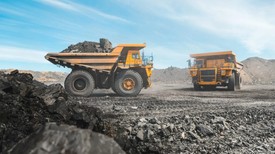Synopsis: South Africa’s mining industry is undergoing a revolutionary transformation through cutting-edge technologies. From autonomous mining robots and AI-driven operations to sustainable practices, this technological evolution is reshaping one of the country’s most crucial sectors. While focusing on critical energy metals and digital mining innovation, the industry faces both exciting opportunities and significant challenges in its journey towards becoming a global leader in modern mining practices.
South Africa’s technological advancements in the mining industry hosts automation and mining robotics, digitalisation and data analytics, as a few. The importance of utilising advanced technology simplified the process of mining and mitigates some of the mining difficulties that hamper the industry. Additionally, moving beyond traditional resources for South Africa still has much work to do, it is currently focused on the “Big Six” metals, these are high grade rare earth elements and they are all critical energy metals. With mining and innovation, the future of jobs and the need for skills development is another vacuum, where the shift from unskilled mining work, to more skilled labour requirements for efficient incorporation of new technologies means the dynamic of labour changes within this industry which has a real-time impact on the state of employment in the country.
Mining Innovation: Automation and Mining Robotics
South Africa has developed in many technological fields. Automation and mining robotics, autonomous drilling and hauling systems are becoming increasingly common in South African mines. Mining robots are being deployed for equipment maintenance and exploration and ore extraction. The precision of these mining robots reduces waste and enhances the mining yield. They also decrease the risk of injury that could otherwise be sustained by humans who are working in the mines.
Digitalisation and Data Analytics: Transforming Mining Operations
In digitalisation and data analytics, advanced sensors and Internet of Things (IoT) devices are installed throughout mining sites gathering real-time data on equipment performance , environmental conditions, and resource levels. This information is processed through data analytics platforms delivering actionable insights , predictions and optimising resource allocation.
Artificial Intelligence and Machine Learning: A Game Changer
Artificial intelligence (AI) and machine learning (ML), AI algorithms are used to analyse data sets and detect patterns and correlations overlooked by human analysts. It predicts the location of mineral deposits with higher accuracy, reducing exploration time and costs. ML models optimise mining operations by adjusting drilling patterns and blasting techniques based on real-time data maximising ore recovery and reducing energy consumption. It serves as a precautionary measure predicting and preventing accidents through perpetual analysis and monitoring of operational data.
Renewable Energy and Sustainability in Mining
Renewable Energy and Sustainability, traditional mining operations have been energy-intensive and have had negative environmental implications. Renewable energy decreases the carbon footprint of mining and energy costs in the longer term. Water management through recycling and treatment technologies help mines decrease their water usage and minimise the effect on local water resources.
The Challenge of Adopting New Mining Technologies
Although there have been significant advancements, South Africa’s mining sector still encounters various obstacles in adopting new technologies. These obstacles include the substantial initial investment required, the demand for skilled workers to manage and sustain advanced systems, and the industry’s reluctance to embrace change. Additionally, implementing new technologies necessitates strong mining cybersecurity measures to protect sensitive information and ensure continuous operations.
The Future of Mining: Investment, Regulation, and Workforce Development
To secure the future of South Africa’s mining sector, it is essential to address these challenges and fully commit to technological mining innovation. Ongoing investments in research and development, partnerships with technology providers, and a focus on enhancing workforce skills are key factors. The government also plays a critical role in fostering a supportive regulatory framework and promoting sustainable practices.
Conclusion: A Technologically-Driven Future for South African Mining
In summary, technological evolution is poised to revolutionise South Africa’s mining sector, enhancing efficiency, sustainability, and resilience. Automation, digitalisation, artificial intelligence, and renewable energy are the driving forces behind this transformation, offering solutions to longstanding issues and opening new avenues for growth. As the sector navigates this transformative phase, it has the opportunity to establish itself as a global leader in responsible and forward-thinking mining practices.





